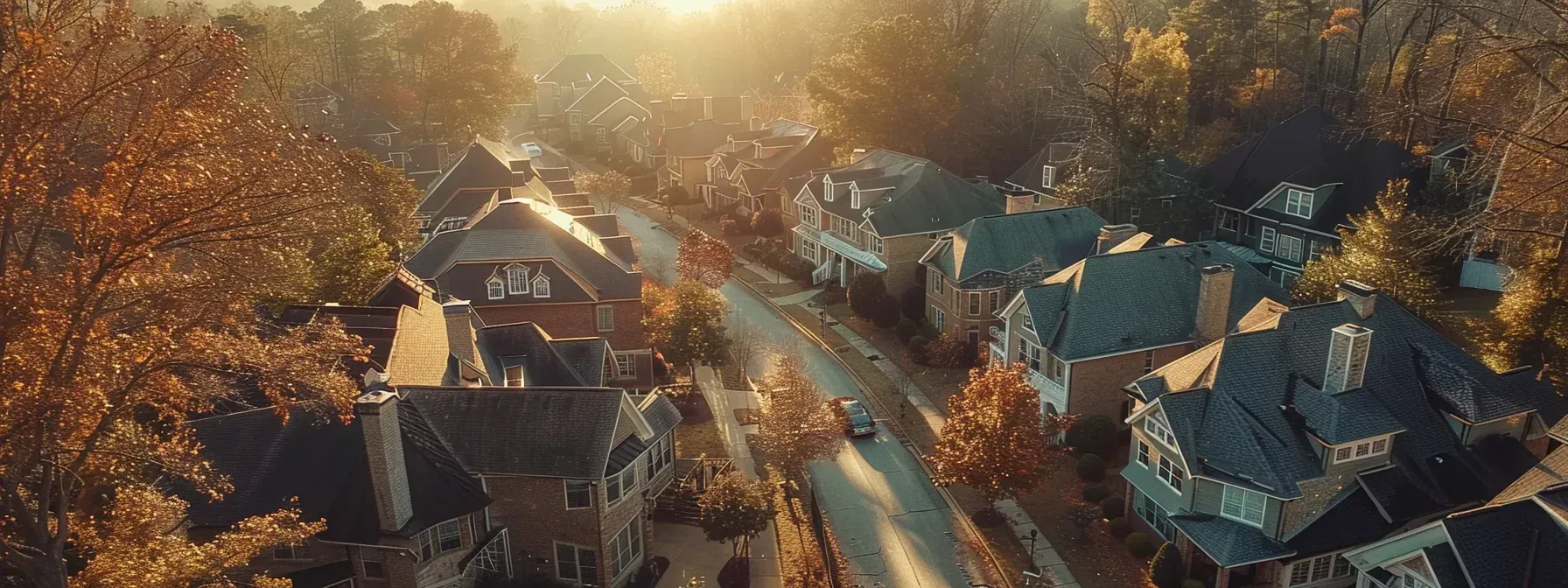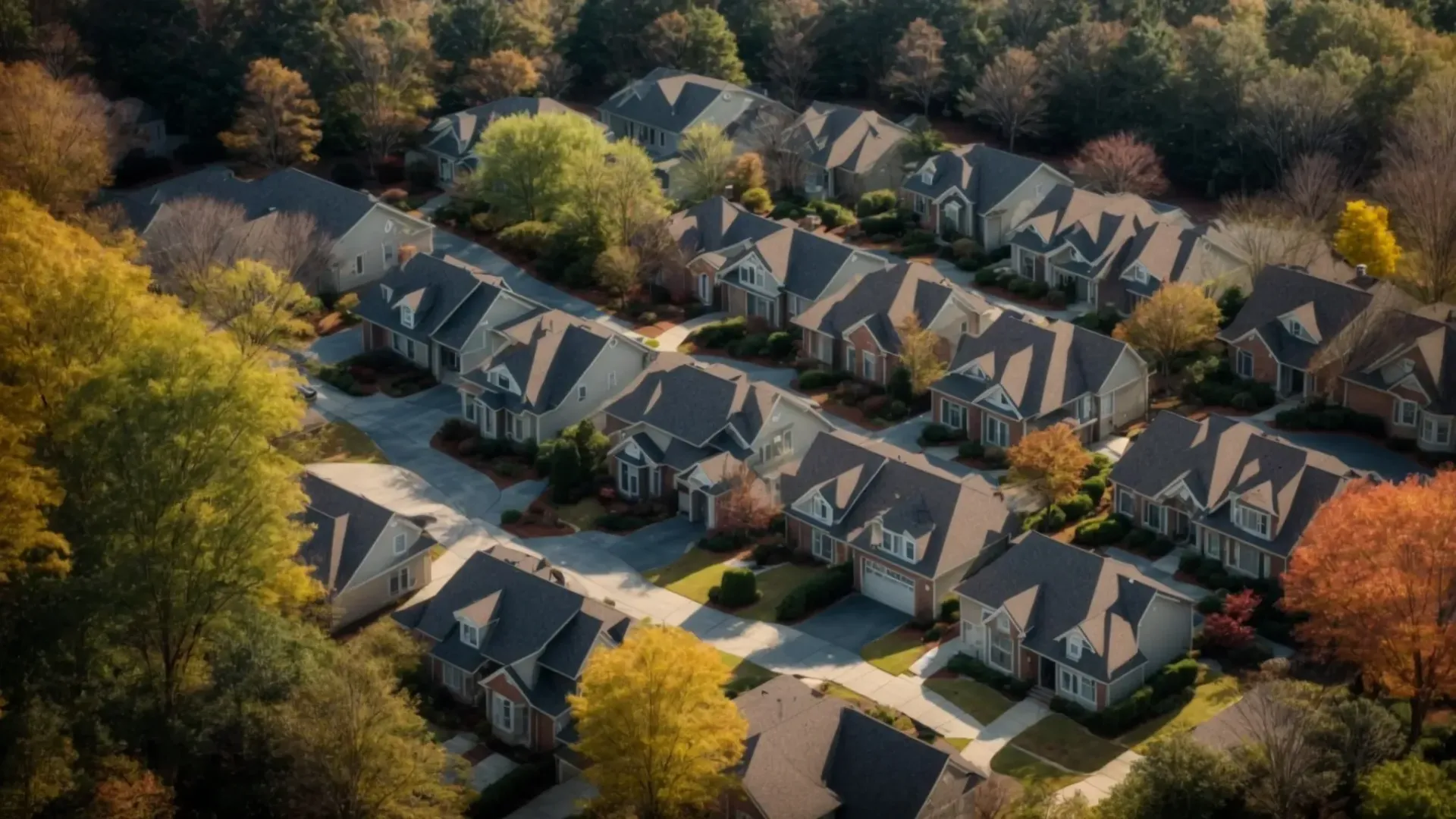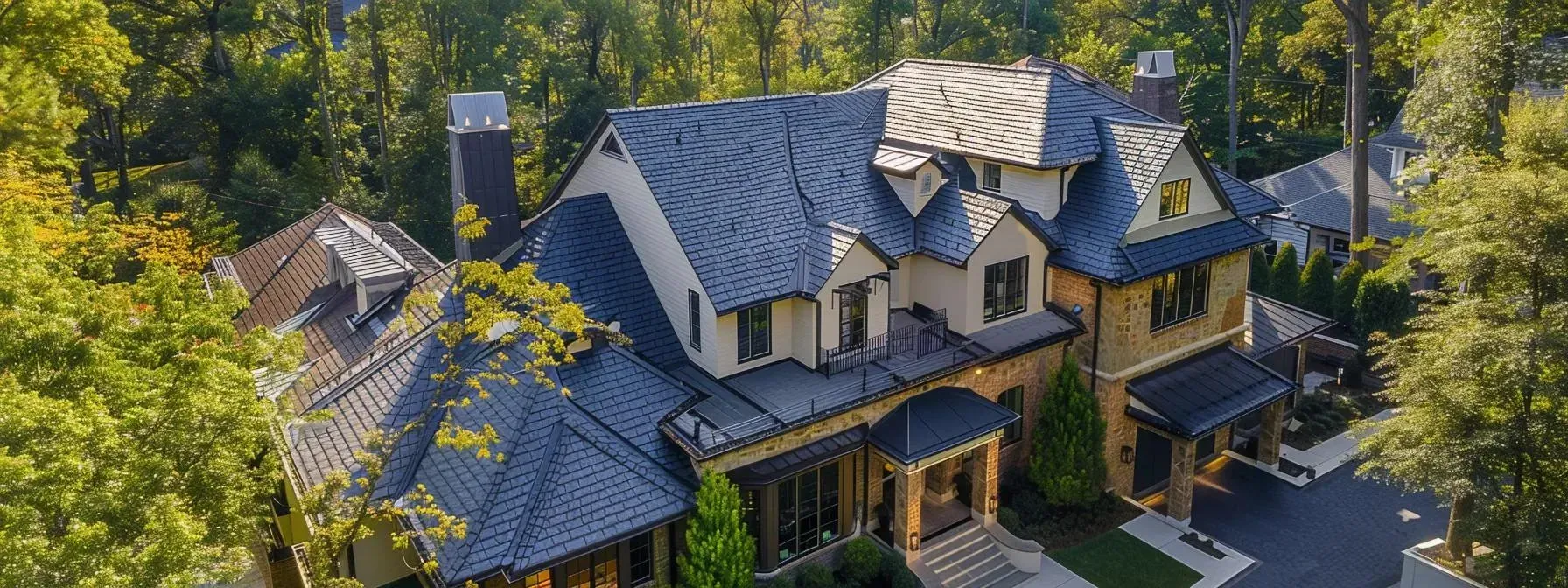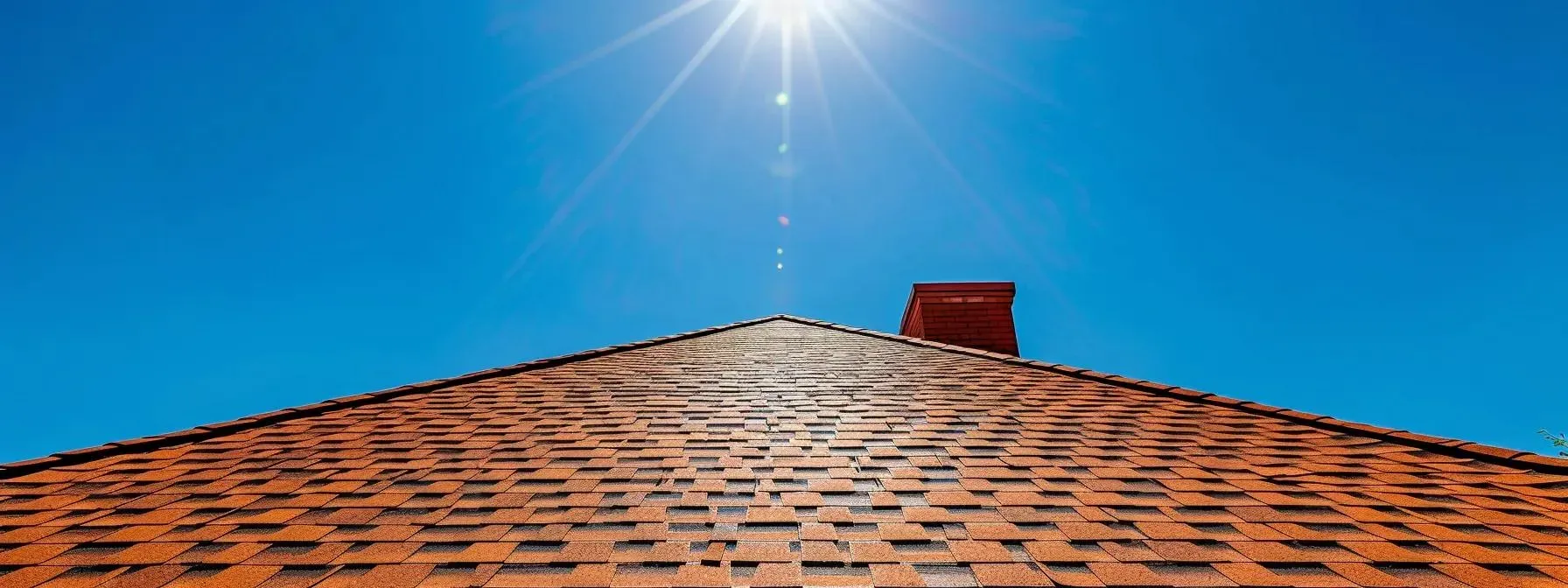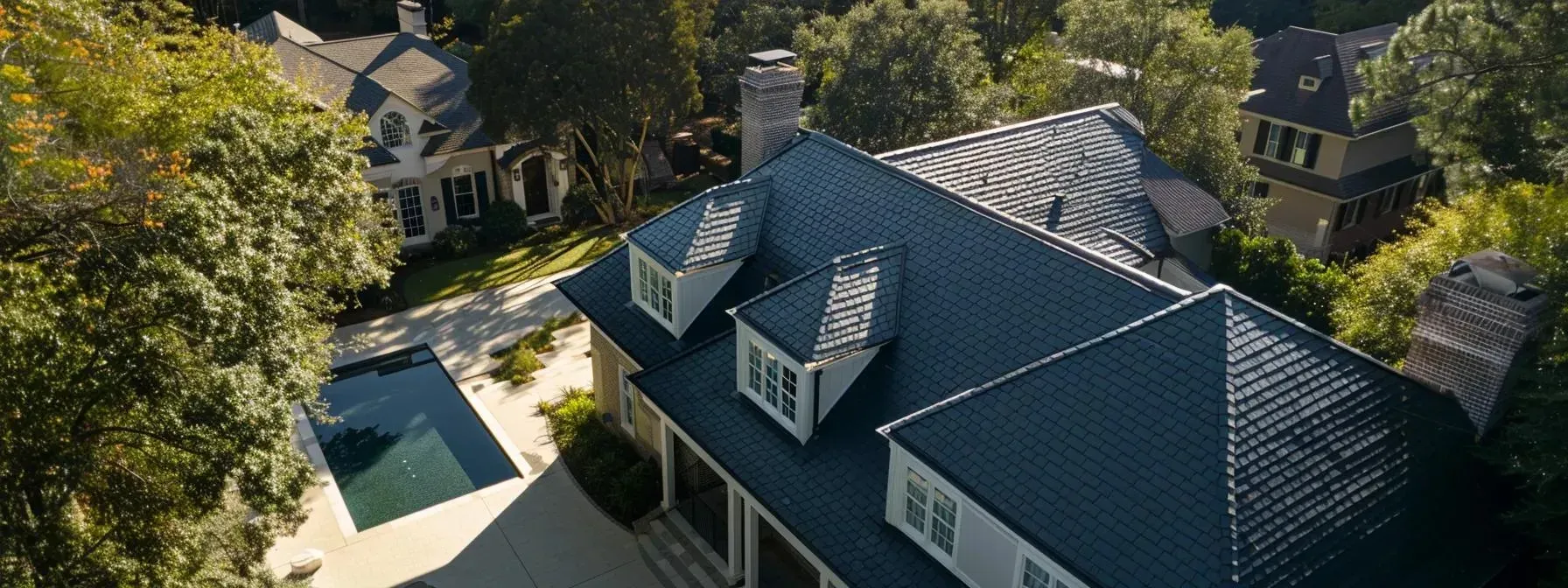By SEO Analysis
•
March 11, 2025
Homeowners needing a roof replacement always balk at beginning the task. They often think it's not in their budget or don't know where to find a reputable roofing company. As far as cost is concerned, it may not be as much as expected, with competitive rates offered by reliable companies, especially in the off-season. Finding out exactly what the cost will be helps homeowners budget wisely and be prepared for the day when they need a new roof. When it comes to roof replacement in Atlanta, many homeowners are unsure about the average costs involved and how to budget effectively. Studies show that prices can vary significantly based on materials used, like copper, and home pitch. This blog post will provide key insights on the average cost of a new roof in Atlanta, highlight the best roofing materials, and guide you on creating a comprehensive budget for your roofing project. By understanding these aspects, readers can tackle common concerns such as mildew development and guarantee a smooth installation process. Understand the Average Cost of a New Roof in Atlanta The average cost of a new roof in Atlanta varies significantly based on several factors. This section will analyze roofing materials, such as wood shingle options, and their price variations. Additionally, labor costs for roofing installation, potential expenses for ventilation, and the impact of roof size and complexity will be evaluated. Understanding these aspects will provide valuable insights for budgeting roofing projects, including roof replacement in Atlanta , and exploring financing options. Analyze Roofing Materials and Their Price Variations When considering the average cost of a new roof in Atlanta, the choice of materials plays a critical role in determining the overall roof replacement cost. For instance, wood shingles can provide a classic aesthetic but may require higher initial investment compared to standard asphalt shingles. Additionally, the roof pitch significantly impacts material requirements and installation complexity, which can affect labor costs. Homeowners should thoroughly evaluate their preferences and budget constraints when selecting roofing materials to align with long-term maintenance and insurance implications. The condition of the existing decking and attic is another essential factor influencing roofing costs. If the decking is damaged or requires replacement, this can add to the overall project expenses. Moreover, proper ventilation in the attic is crucial for maintaining both the roof’s integrity and energy efficiency. By analyzing these various components, homeowners can better anticipate costs and make informed decisions that not only meet their immediate needs but also enhance their property’s value and longevity. Consider Labor Costs for Roofing Installation Labor costs for roofing installation in metro Atlanta can significantly influence the overall expenses for homeowners. These costs are impacted by factors such as the complexity of the project, the type of roofing materials chosen, and the skill level of the contractors involved. Generally, experienced professionals may charge a premium, but their expertise can lead to a more durable and effective roof system, which is crucial for avoiding future roof repair needs. Homeowners should also consider the potential for additional expenses related to labor, such as the removal of existing roofs or the need for repairs to the underlying structure. Understanding these factors can help homeowners better budget for their roofing projects. By evaluating labor costs alongside other expenses, such as window replacement cost or roofing materials, they can plan more effectively and make sure their investment yields long-term benefits for their properties. Explore Potential Additional Expenses in Roofing Projects When creating a roof replacement estimate, homeowners in Atlanta should factor in additional expenses beyond just materials and labor. Issues like damage from hail may necessitate unforeseen repairs to the underlying structure or even the chimney, adding to the overall cost. Homeowners can minimize surprises by consulting with reputable roofing contractors who can assess the existing conditions and provide a comprehensive quote that includes potential additional expenses. Moreover, any necessary upgrades or construction modifications should be included in the total budget. For instance, if the current roof requires reinforcement or if the homeowner opts for a high-quality asphalt shingle, this could influence the final expenses. By anticipating these costs and planning accordingly, homeowners can make sure their roofing project remains within budget while addressing all necessary repairs and enhancements for long-term durability. Evaluate the Costs of Roof Repairs Versus Replacement Homeowners in Atlanta often face the dilemma of choosing between roof repairs and a full replacement. While minor leaks may be manageable through targeted repairs, persistent problems indicate that a complete overhaul might be a more cost-effective solution in the long run. Investing in high-quality residential roofing can lead to energy savings and improved property value, especially if the current system is outdated or not up to manufacturing standards. When evaluating costs, it is essential to assess the roof's overall condition, including factors such as the materials used and any underlying structural issues. For example, if repairs frequently occur, the accumulated costs can surpass those of a new roof. By understanding the implications of both options, homeowners can make informed decisions that align with their financial goals and protect the longevity of their investment. Review Financing Options for Roofing Projects Homeowners exploring roof replacement options in Atlanta should consider various financing methods to manage costs effectively. Many roofing services offer payment plans that allow customers to spread expenses over time, making it easier to afford necessary upgrades, such as a new metal roof or concrete flat roof. Additionally, some contractors provide assistance in identifying potential financing programs or home improvement loans, which can help ease the financial burden associated with roof installation. It is also advisable for homeowners to research local grants or incentives for energy-efficient roofing solutions. For instance, choosing a metal roof may qualify for rebates or tax incentives. By examining these financing options, homeowners can better align their roofing projects with their budgets while they invest in durable and sustainable roofing materials that enhance property value and long-term performance. Factor in the Impact of Roof Size and Complexity on Pricing The size and complexity of a roof significantly influence its overall cost. Larger roofs require more materials, such as shingles and flashing, and typically involve more intricate designs, which can increase labor expenses. For homeowners, working with an experienced roofing contractor can provide clarity on how these factors affect pricing and help develop a suitable budget that considers potential costs for water damage protection and ongoing safety enhancements. Complex roof structures may necessitate additional services from skilled roofers, including specialized installation techniques and extra safety measures. A knowledgeable contractor can assess the specifics of the roofing project and provide insights on expected costs associated with various complexities, making sure homeowners are prepared for both immediate and long-term expenses. This understanding can lead to informed decision-making that prioritizes both quality and financial planning. Identify the Best Roofing Materials for Atlanta Homes Understanding the best roofing materials for Atlanta homes is vital for homeowners planning to replace their roofs. Key considerations include comparing the benefits of asphalt shingles and metal roofing, investigating the longevity and advantages of tile roofs, and examining the suitability of flat roofs for local climates. Furthermore, assessing the environmental impact of various options, weighing aesthetic appeal, and factoring in local building regulations and warranties are essential for making informed decisions. This guidance helps homeowners select materials that align with their needs and enhance their property value. Compare the Benefits of Asphalt Shingles and Metal Roofing Asphalt shingles and steel roofing each offer unique advantages, catering to varying homeowner needs in Atlanta. Asphalt shingles are often favored for their affordability and aesthetic versatility, making them suitable for a wide range of architectural styles. However, they may require more frequent inspection and maintenance due to wear and tear, resulting in shorter lifespans compared to metal roofs, which are known for their exceptional durability and resistance to extreme weather conditions. Metal roofing, especially in steel, boasts longevity and the ability to withstand the challenges posed by Atlanta's climate. Homeowners can benefit from potential energy savings and reduced insurance costs, as steel roofs typically comply with local building codes aimed at enhancing safety and property value. Although the initial investment may be higher, the long-term performance and low maintenance of metal options can offset these costs, making them a wise choice for those prioritizing durability and value over time. Investigate the Longevity of Tile Roofs and Their Advantages Tile roofs, including slate options, are well-regarded for their longevity, often lasting over 50 years with proper maintenance. This durability can significantly impact roof replacement costs, giving homeowners a long-term solution that reduces the frequency of renovations. Additionally, policies related to homeowners’ insurance may offer benefits for those choosing tile roofs due to their resilience against harsh weather conditions, which can also contribute to minimizing repair expenses over time. Moreover, the aesthetic appeal of tile roofs can enhance the overall value of a property, making them a popular choice for homeowners looking to improve their home’s exterior. With a tile roof, homeowners may also notice a positive effect on their indoor climate, as these materials effectively regulate temperatures and help lower cooling costs. By investing in a durable roofing solution, homeowners can enjoy peace of mind knowing that their ceiling and interior spaces are protected from the elements, while also boosting their property's marketability. Examine the Suitability of Flat Roofs for Local Climates Flat roofs can be a suitable option for certain structures in Atlanta, especially commercial buildings that benefit from ease of accessibility for maintenance and repair. Their design allows for efficient water drainage, which is crucial for preventing water pooling, particularly in the rainy season. When evaluating this choice, property owners should also consider the return on investment, as flat roofs may require more frequent roofing replacement compared to pitched roofs, influencing long-term budget plans. Longevity can vary with flat roofing materials, so selecting high-quality options is essential for maximizing durability. For instance, while some may opt for a rubber membrane or modified bitumen, these materials can offer different lifespans and maintenance needs. Understanding the suitability of flat roofs, alongside assessing any additional structural requirements, helps homeowners make informed decisions that align with their specific climate challenges and property needs. Assess the Environmental Impact of Different Roofing Options Assessing the environmental impact of different roofing options is essential for homeowners in Atlanta, especially considering severe weather conditions common in Georgia. Selecting sustainable materials can significantly reduce energy consumption and utility expenses over time. For instance, metal roofs not only have a long lifespan but also reflect sunlight, helping to keep indoor temperatures lower and reducing the need for air conditioning during the hot summer months. Moreover, roofing choices like a gable roof can improve ventilation, enhancing energy efficiency throughout the home. Homeowners should consider both the initial cost and the long-term benefits of various roofing materials. By investing in environmentally friendly options, they not only contribute to sustainability but also potentially increase the value of their property while providing resilience against Atlanta's challenging climate. Weigh the Aesthetic Appeal of Various Roofing Styles The aesthetic appeal of roofing styles can significantly enhance the overall look of Atlanta homes, influencing the property’s value and neighborhood character. Styles such as dormers not only add visual interest but can also improve energy efficiency by providing better ventilation. Additionally, material choices that withstand strong wind can complement the home’s design while giving durability against the elements, which may positively impact insurance policy rates. Selecting a roofing style that aligns with the architectural features of a home, such as a low-slope or steep-pitched roof, is essential for maximizing curb appeal. For instance, a high-quality metal roof may provide not only a modern, sleek look but also long-term cost savings measured in square foot efficiency. Homeowners should consider these factors carefully to make sure their investment in roofing not only meets their immediate aesthetic desires but contributes to the home's enduring performance and value. Consider Local Building Regulations and Material Warranties Understanding local building regulations is essential for homeowners in Atlanta who wish to select the best roofing materials, such as metal or gable roofs. Regulations can vary by zip code, impacting the types of materials and designs permitted in certain areas. By adhering to these guidelines, customers can make sure their roofing projects not only meet legal standards but also enhance the overall safety and aesthetic appeal of their homes. In addition to regulations, exploring material warranties is crucial for long-term investment. High-quality materials often come with substantial warranties, which provide peace of mind against defects or premature deterioration. For instance, metal roofs typically feature extensive warranties due to their durability, making them a wise choice in Atlanta's challenging climate, where weather conditions can accelerate wear and tear. Understanding these warranties helps customers choose materials that will deliver both durability and value over time. Create a Comprehensive Budget for Your Roofing Project Creating a comprehensive budget for roofing projects in Atlanta involves several key components. Homeowners must identify all potential costs associated with roof installation, including fees for various materials like EPDM rubber. Setting aside savings for unexpected expenses helps them manage issues that arise during the replacement process, while also exploring local grants or rebates for upgrades. Establishing a clear timeline and budget milestones is essential for staying on track. Additionally, reviewing payment options and scheduling with contractors can facilitate a smooth roofing experience. This planning allows effective allocation of funds and maximizes value while addressing important considerations, such as pest control during installation. List All Potential Costs Associated With Roof Installation Understanding all potential costs associated with roof installation is essential for homeowners embarking on a home improvement journey in Atlanta. Key expenses include the price of materials, such as clay tiles or asphalt shingles, which vary significantly in quality and durability. Additionally, homeowners should budget for the labor involved in residential roofing services, as costs may increase based on the roof's length and complexity, including features like valleys or intricate designs. Other factors impacting the overall cost of installation include the need for underlayment, flashing, and ventilation systems that add to the roof's longevity. Homeowners should also consider disposal fees for old roofing materials and any structural repairs required during the installation process. By taking a comprehensive approach to budgeting, including these potential expenses, homeowners can make informed decisions that align with their financial goals while receiving quality and durability in their roofing projects. Include Savings for Unexpected Expenses During the Project When planning a roofing project, homeowners in Atlanta should allocate a portion of their budget for unexpected expenses. Issues such as hidden damage to underlying structures or the need for additional materials can arise during installation. By setting aside funds for these contingencies, property owners can avoid financial strain if they encounter unforeseen complications that require immediate attention. Furthermore, including savings for potential expenses can enhance overall project management. For instance, a sudden storm may lead to additional protective measures or temporary repairs. A well-prepared budget not only improves peace of mind but also confirms the roofing project stays on track, effectively safeguarding the investment made in residential roofing. Research Local Grants or Rebates for Roofing Upgrades Researching local grants or rebates for roofing upgrades can substantially impact the budget for a new roof in Atlanta. Many homeowners may not be aware of available programs that provide financial assistance for energy-efficient roofing projects. By contacting local government offices or community organizations, property owners can uncover potential incentives that lower their overall costs, making high-quality roofing materials more accessible. Furthermore, some utility companies in Georgia offer rebates for homeowners who invest in energy-saving roofing options. For instance, selecting materials with high solar reflectance can yield incentives that contribute to reduced energy expenses over time. By taking advantage of these financial opportunities, homeowners can enhance their roofing projects while also improving their property's long-term sustainability and value. Set a Timeline and Budget Milestones for Your Roof Project Setting a timeline and defining budget milestones are essential steps for homeowners planning a roofing project in Atlanta. Establishing a clear timeframe helps in coordinating with contractors, securing permits, and minimizing disruptions to daily life. By outlining key phases, such as material selection and installation, homeowners can guarantee their roofing project maintains momentum while aligning with their budgetary constraints. Budget milestones should reflect both expected and potential expenses at various stages. For instance, homeowners might allocate funds for an initial deposit upon contract signing and additional payments tied to specific completion benchmarks. This structured approach not only fosters accountability throughout the project but also allows homeowners to adjust their budget as needed, making sure the overall costs align with their financial goals without unexpected burdens. Review Payment Options and Scheduling With Contractors Engaging with contractors about payment options is an essential step for homeowners planning a roofing project in Atlanta. Many roofing companies offer flexible payment plans that allow homeowners to make payments over time, easing the financial burden of a new roof. By discussing these payment arrangements early in the process, homeowners can find a solution that fits their budget and provides successful completion of their roofing project. Additionally, scheduling with contractors is crucial for timely project completion. Homeowners should communicate their preferred timelines and be aware of the contractors' availability. Establishing a clear schedule helps in coordinating the roofing process, thereby minimizing disruptions and making sure all aspects of the project align with the intended budget and duration. Find Reputable Roofing Contractors in Atlanta Finding reputable roofing contractors in Atlanta is essential for a successful project. Homeowners should evaluate online reviews and testimonials to gauge local contractor performance. It's also vital to check for insurance and licensing details, obtain multiple quotes, and consider contractor experience and their project portfolio. Analyzing contracts and warranties before signing, along with asking for references, will help verify the reliability of chosen contractors. Evaluate Online Reviews and Testimonials for Local Contractors Evaluating online reviews and testimonials can provide homeowners in Atlanta with critical insights into the reliability and performance of local roofing contractors. Reputable platforms, such as Google and Yelp, often feature genuine feedback from past clients, allowing potential customers to compare experiences and service quality. This evaluation assists homeowners in making informed decisions, particularly in terms of understanding the average cost of a new roof and helping them get the best value for their investment. When assessing reviews, homeowners should look for consistent themes, such as punctuality, communication skills, and overall satisfaction with the completed work. Contractors with a strong track record of positive feedback are more likely to deliver dependable services at competitive prices. Engaging with these reviews helps prospective clients weigh their options effectively and select a roofing contractor who aligns with their needs and budget considerations. Recommend Checking for Insurance and Licensing Details When selecting a roofing contractor in Atlanta, it is crucial to verify their insurance and licensing details. Licensed contractors must adhere to local regulations and building codes, which guarantees the work meets safety standards. Additionally, insurance coverage protects homeowners from liability in case of accidents during the roofing project, safeguarding their investment in a new roof. Homeowners should request proof of both insurance and licensing before hiring a contractor. This step not only assures compliance with local laws but also provides peace of mind regarding the quality of work to be performed. By choosing a reputable contractor with the proper credentials, homeowners can rest assured that their roofing project is in capable hands, minimizing the risk of unexpected costs associated with faulty installations or inadequate repairs. Suggest Obtaining Multiple Quotes From Different Contractors Obtaining multiple quotes from different contractors is a crucial step for homeowners in Atlanta looking to understand the average cost of a new roof. By gathering estimates from various licensed and experienced professionals, homeowners can compare pricing, services offered, and overall value. This practice not only reveals the competition of roofing services but also helps identify potential red flags, such as unusually low bids that may indicate subpar materials or labor. In addition to cost comparison, multiple quotes provide opportunities for homeowners to ask questions and gauge each contractor's expertise and customer service quality. Engaging with different contractors allows them to present specific concerns regarding their roofing needs so that selected materials and methods align with long-term goals. Evaluating the differences in quotes helps homeowners make informed decisions, ultimately leading to a successful roofing project that meets both their budget and quality expectations. Discuss the Importance of Contractor Experience and Portfolio Contractor experience plays a vital role in the success of roofing projects in Atlanta. An experienced contractor brings valuable knowledge about local building codes and regulations, which secures compliance and safety during installation. Furthermore, a well-established contractor is likely to have a portfolio showcasing previous work, providing homeowners with insight into their quality and craftsmanship. This information can ease concerns about the reliability of the services being offered, helping homeowners feel more confident in their choice. A comprehensive portfolio highlights the contractor’s versatility and capability in handling various roofing materials and styles, from asphalt shingles to metal roofs. By reviewing such portfolios, homeowners can assess whether the contractor's aesthetic aligns with their vision for the property. Additionally, it serves as a direct indicator of past performance, enabling homeowners to choose a professional with a proven track record, ultimately contributing to long-term satisfaction and enhancing the property’s value. Analyze Contracts and Warranties Before Signing Before signing any contract with roofing contractors in Atlanta, homeowners should take the time to thoroughly analyze the terms and conditions outlined in the agreement. Key details to look for include the scope of work, payment terms, and timelines for project completion. This careful evaluation can help prevent misunderstandings and protect against unexpected costs that may arise during the roofing project. Warranties offered by roofing contractors are equally important, as they provide assurance regarding the quality of materials and workmanship. Homeowners should inquire about both manufacturer and workmanship warranties, helping them understand what is covered and for how long. Reviewing these details allows homeowners to make informed choices, ultimately supporting their budgeting efforts by safeguarding their investment in a new roof. Ask for References to Verify Contractor Reliability When selecting a roofing contractor in Atlanta, asking for references is a vital step in verifying the reliability of the professional. Speaking with previous clients allows homeowners to gain insight into the contractor's performance, communication style, and overall satisfaction with the completed work. This feedback can help them discern which contractors consistently deliver quality service and products that align with budgeting needs for roofing projects. Homeowners should not only request references but also follow up by asking specific questions about the contractor's work. Inquiries about the time taken for project completion, adherence to budgets, and the quality of materials used can reveal critical information that influences decision-making. By gathering references and discussing past projects, homeowners can make informed choices so their investment leads to a durable and aesthetically pleasing roofing solution. Prepare for Your Roof Installation Day Preparing for roof installation day is essential for a smooth project. Homeowners should clear the area around their home for easy access and inform neighbors about the upcoming work. Making sure pets are kept safe is also crucial. Additionally, creating a checklist for materials and equipment, planning for potential weather disruptions, and communicating preferences with the roofing team will contribute to an efficient installation process. Clear the Area Around Your Home for Easy Access Clearing the area around the home before roof installation is crucial for a smooth and efficient project. Homeowners should remove any vehicles, outdoor furniture, and decor items that may obstruct access for the roofing crew. This preparation not only facilitates the safe movement of workers but also protects personal belongings from potential damage during the installation process. Furthermore, homeowners must consider the safety of pets and children on the installation day. Keeping pets indoors or in a secure area away from work zones minimizes distractions and potential hazards. By proactively creating a clean and accessible environment, homeowners contribute to a more organized roofing project, ultimately enhancing the overall efficiency and effectiveness of their investment in a new roof. Inform Neighbors About the Upcoming Roofing Work Informing neighbors about upcoming roofing work is a key step for homeowners in Atlanta planning a roof installation. Not only does it preserve good relationships within the community, but it also allows neighbors to prepare for potential disruptions, such as noise and increased traffic around the property. Providing this heads-up can help avoid misunderstandings and make sure everyone is on the same page regarding the project timeline. Homeowners should consider sending a simple note or having a quick conversation with their neighbors to explain the roofing project and its expected duration. This proactive communication can be particularly valuable for those living in close proximity, as some might require adjustments to their schedules during the installation. Taking the time to inform neighbors can result in a smoother process and contribute positively to the overall neighborhood dynamic. Ensure Pets Are Kept Safe During the Project Keeping pets safe during a roofing project is a critical consideration for homeowners in Atlanta. Loud noises, unfamiliar workers, and increased activity around the home can create stress for animals, leading to potential safety concerns. Homeowners should make sure their pets are secure in a quiet room away from the work area or consider utilizing a pet boarding facility for the duration of the project, allowing both pets and workers to remain safe. In addition to securing pets, homeowners must communicate with family members about potential hazards associated with the roofing installation. Informing everyone about the need to keep pets indoors and away from areas where work is being performed can prevent accidents. By prioritizing pet safety, homeowners can deliver a smoother installation experience while alleviating concerns about their furry companions during this busy time. Create a Checklist for Materials and Equipment Needed Creating a checklist for materials and equipment needed for roof installation helps streamline the process, making sure all crucial items are available before work begins. This preparation can include roofing materials such as shingles, underlayment, and flashing, along with tools like nail guns, ladders, and safety gear. Having everything organized prevents delays and unexpected costs that can arise from missing items during the installation. Homeowners should also consider including cleanup supplies in their checklist, such as tarps and debris bags, to efficiently manage waste generated during the project. By preparing this checklist ahead of time, homeowners can contribute to a smoother installation experience and maintain focus on budget while their new roof is finished safely and effectively. Plan for Weather Disruptions on the Installation Day Planning for weather disruptions on installation day is crucial for maintaining the schedule and budget of roofing projects in Atlanta. Contractors typically monitor weather forecasts closely and may provide advice on timing to avoid rain or strong winds that can hinder work. Homeowners can prepare by making sure the roofing materials are ready and securely stored, minimizing delays caused by unfavorable conditions. Moreover, having a flexible timeline allows teams to adjust their schedules in response to unexpected weather changes. Homeowners should communicate with their roofing contractors before installation to discuss contingency plans, including potential delays and how they may affect overall project costs. This proactive approach helps manage expectations and enables effective adjustments and a smooth roofing installation process. Communicate Your Preferences With the Roofing Team Effective communication with the roofing team is crucial for guaranteeing the roofing project in Atlanta meets the homeowner's expectations. Homeowners should clearly articulate their preferences regarding materials, design, and any specific requirements they have for their new roof. This dialogue not only helps the team understand the vision but also allows them to provide insights into cost implications and potential alternatives that align with the homeowner's budget. Engaging in open discussions with the roofing professionals can lead to a more satisfactory experience. Homeowners may want to share concerns about noise levels, work hours, or safety measures so that all needs are considered. By establishing clear lines of communication, homeowners can create a collaborative environment that prioritizes both quality and cost-effectiveness in their roofing project, ultimately resulting in a durable roof that enhances the property's value. Maintain Your New Roof for Longevity Scheduling regular roof inspections and maintenance is crucial for maximizing the lifespan of a new roof. Homeowners should clean gutters and downspouts to prevent water damage, check for signs of wear or leaks after storms, and consider professional maintenance agreements with contractors. Addressing issues promptly can avoid costly repairs, while documenting maintenance activities provides a useful reference for future needs. Schedule Regular Roof Inspections and Maintenance Scheduling regular roof inspections and maintenance is essential for the longevity of a new roof. Homeowners in Atlanta should aim to have their roofs inspected at least once a year and after significant weather events, such as storms or heavy rains. These proactive measures help identify potential issues early, preventing costly repairs down the line and optimizing the roof's performance. Moreover, routine maintenance tasks like cleaning gutters and checking for signs of wear can contribute significantly to a roof's lifespan. By investing time in these simple upkeep activities, homeowners can safeguard their roofs against leaks and other damages, which can affect not just the roof itself but also the structure of the home. This proactive approach enhances overall property value and aligns with the financial goals of homeowners looking to maximize their investment in roofing services. Clean Gutters and Downspouts to Prevent Damage Regularly cleaning gutters and downspouts is essential for maintaining a new roof's longevity, particularly in Atlanta's variable climate. Clogged gutters can lead to water overflow, causing damage to roofing materials and the underlying structure. Homeowners should make sure their gutters are free from debris to facilitate proper drainage, minimizing the risk of costly repairs down the line. In addition to preventing water damage, well-maintained gutters support overall roof performance, ultimately contributing to the property's value. Homeowners may consider scheduling seasonal cleanings or installing gutter guards to alleviate maintenance concerns. By proactively addressing gutter upkeep, individuals can protect their roofing investment and enhance the overall efficiency and durability of their home. Check for Signs of Wear or Leaks After Storms After a storm, homeowners in Atlanta should promptly inspect their roofs for signs of wear or leaks. Attention to small issues, such as missing shingles, cracked tiles, or water stains on ceilings, can prevent costly repairs and extend the lifespan of the roofing system. Implementing this proactive approach helps make sure any potential problems are addressed before they escalate into more significant expenses. In addition to visual inspections, it is advisable for homeowners to check the attic for signs of moisture or leaks following severe weather. This area often reveals hidden water damage that might not be immediately visible from outside. Addressing these issues quickly not only safeguards the roof's integrity but also protects the overall structure of the home, aligning with effective budgeting strategies for maintaining a new roof in Atlanta. Consider Professional Maintenance Agreements With Contractors Engaging in professional maintenance agreements with contractors can provide significant value for homeowners in Atlanta. These agreements often include routine inspections, annual maintenance, and emergency repairs, helping to spot potential issues before they escalate into costly problems. For example, a maintenance plan can make sure the roof remains structurally sound and free from leaks, ultimately extending its lifespan and protecting the homeowner’s investment. Moreover, opting for such agreements can lead to more predictable budgeting for roofing services. Homeowners can allocate funds knowing that regular upkeep is taken care of, reducing the likelihood of unexpected expenses caused by neglect. This proactive approach not only enhances the roof's durability but also contributes to maintaining property value, making it a wise choice for those looking to optimize their roofing investment in Atlanta's varied climate. Address Issues Promptly to Avoid Costly Repairs Addressing roofing issues promptly is essential for avoiding costly repairs in Atlanta. For instance, if a homeowner notices a small leak, taking swift action to seal it can prevent water damage that may compromise the integrity of the roof and the structure beneath it. Regular inspections after significant weather events are a practical way for property owners to identify such problems early so a minor issue does not escalate into a major repair that could strain their roofing budget. Homeowners should also prioritize maintaining proper ventilation in their roofs, as inadequate airflow can lead to moisture buildup and damage. By engaging with professional roofing services to conduct routine check-ups, homeowners can mitigate risks associated with neglecting these issues. This proactive maintenance approach not only extends the lifespan of a new roof but also protects their investment, contributing to long-term savings and enhancing the overall property value. Document Maintenance Activities for Future Reference Documenting maintenance activities is essential for homeowners in Atlanta aiming to prolong the lifespan of their new roof. Keeping a detailed record of inspections, repairs, and routine upkeep creates a valuable reference that can inform future maintenance decisions. This documentation not only helps track the condition of the roof over time but also aids in identifying any emerging issues promptly, ultimately contributing to a well-maintained roofing system. Furthermore, having a comprehensive maintenance log can be beneficial when dealing with insurance claims or warranty concerns. Homeowners can quickly provide evidence of routine check-ups and necessary repairs, which may enhance their credibility and expedite any claims process. By prioritizing documentation, individuals not only elevate their investment in roofing services but also foster a proactive approach to home maintenance that safeguards their property against unexpected costs and damages.
